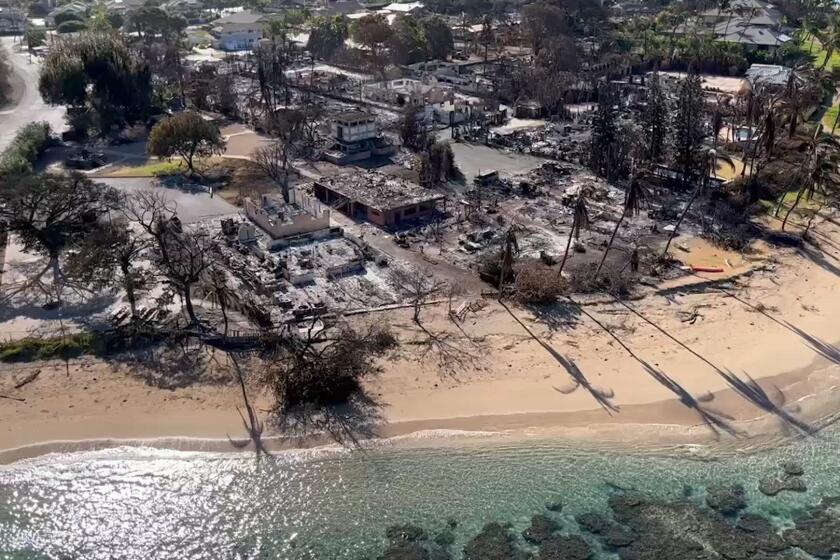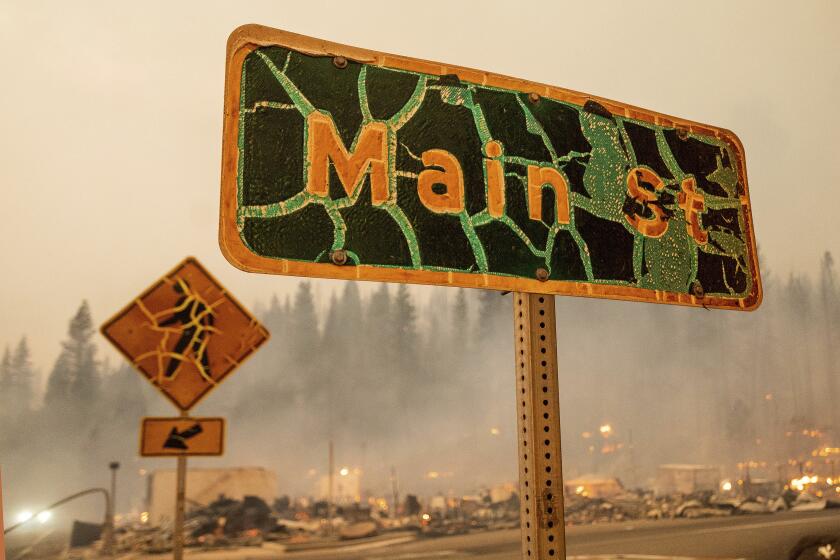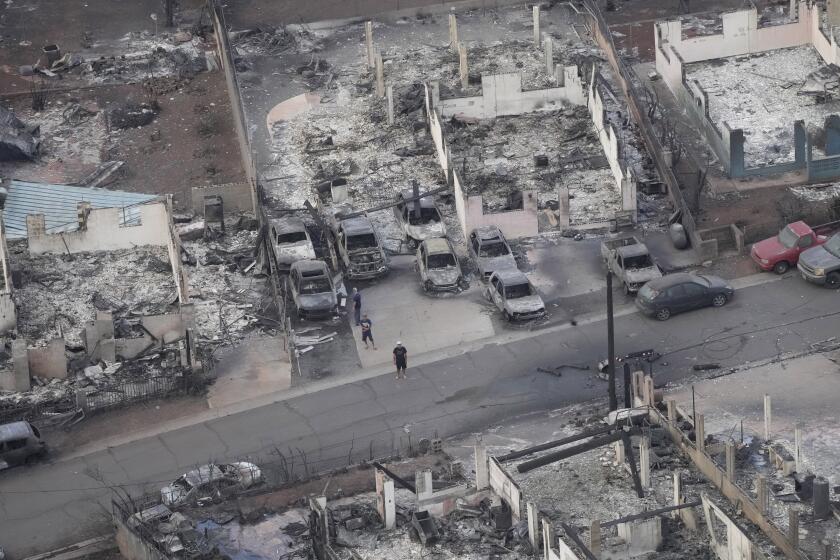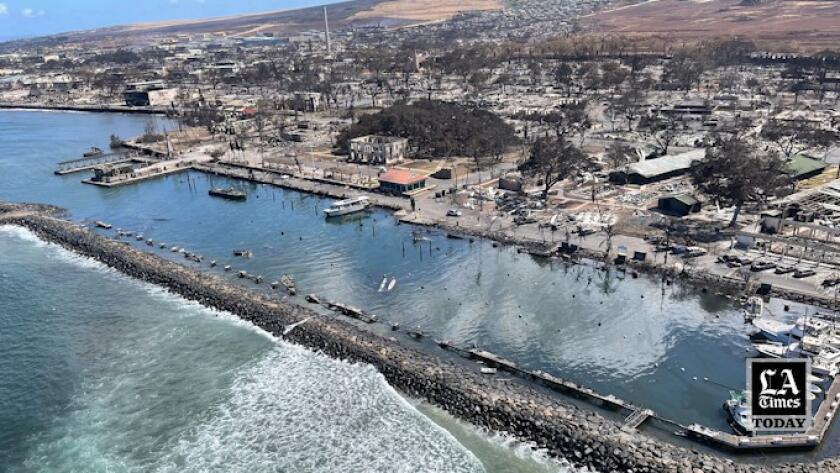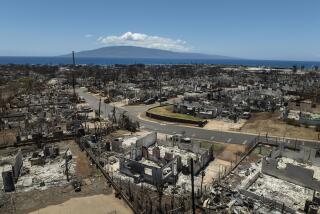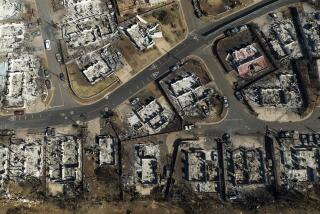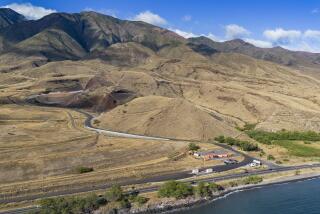Column: As Lahaina mourns tragedy, another crisis is coming
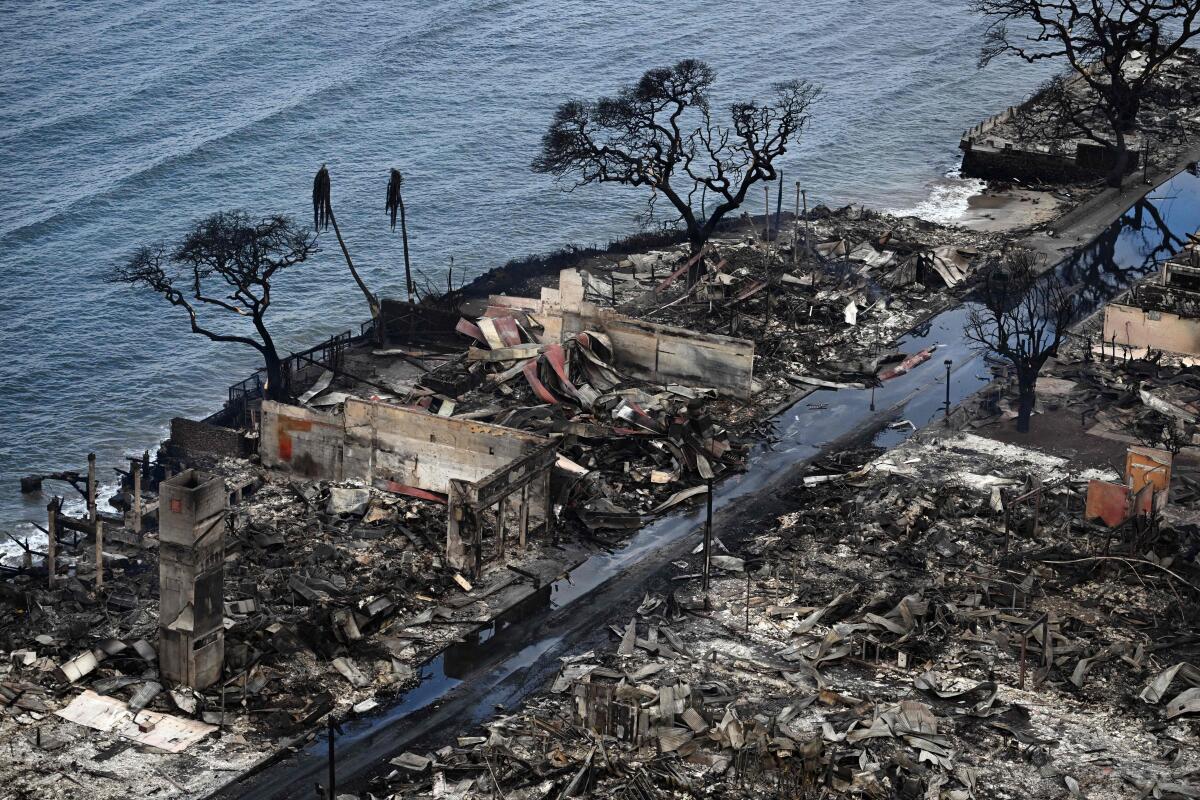
It’s easy to characterize Lahaina as a tourist town, though it was much more.
Was. Before the fire.
“What was Lahaina is no longer Lahaina,” Carmen “Hulu” Lindsey told me Thursday.
She’s the chair of the Office of Hawaiian Affairs, and she was evacuated from a mountain enclave during the recent blazes — waking up at 3 a.m. to the blare of a cellphone alert. She grabbed her two golden retrievers and headed to her daughter’s house through winds so strong it felt like a hurricane, flames visible on the brown hills.
Everything to be said about Lahaina — the physical place, if not its soul — is now past tense, she said. In a community of 13,000, 67 are confirmed dead with the search continuing as of Friday. More than 270 structures are gone, and hundreds of people remain unaccounted for.
A Maui tourist hub looks like a wasteland, with homes and entire blocks reduced to ashes in one of the deadliest U.S. blazes in recent years.
And though the trauma is still too fresh to fully comprehend, we know thousands are displaced right now. At a minimum, hundreds will have no home to return to when authorities open the roads and allow people to return.
“This is like climate change saying welcome to the rest of our lives,” Camilo Mora told me Thursday from Colombia, where he is visiting from his adopted home on Oahu. He’s a professor of geography and environment at the University of Hawaii, specializing in the ways our planet is changing.
California needs a plan for how and where we will live in the future.
For Mora, who has made it his personal mission to help Hawaii become more resilient to the rising global thermometer, the catastrophe of Lahaina was “not surprising at all.”
The age of climate change has exploded into the age of climate migration — though we have yet to collectively acknowledge it — and an urgent need to be realistic about what is coming and how we adapt. We can no longer pretend that ingenuity and perseverance will overcome the perils of our warming planet.
Islands have long been the bellwether of climate change, with rising sea levels, rising temperatures, vulnerability to drought (it’s hard to ship water in when it runs out) and, increasingly, weather extremes from wildfires to floods.
They are also expensive places to live, in no small part because tourist economies are a double-edged sword that can drive up costs.
Islands like Maui make it obvious that global warming is an economic and equity issue as much as an environmental one, because only the wealthy will be able to recover quickly. Only the lucky and resourceful will be able to recover at all.
Too many will simply find themselves on a downward trajectory of instability and poverty that makes rebuilding a house or a life in the same place impossible — as we have seen in other fire-devastated towns such as Paradise, Calif. Government aid has yet to find a way to sufficiently protect against this ugly and unpopular fact. But we are increasingly seeing something that previously felt as though it happens only in far-away places: Natural disasters driving away whole populations.
“This is moving from concerning to terrifying when you see this happening in your backyard,” Mora said.
Just a few days ago, Front Street, Lahaina’s main tourist drag, was crowded with shops and restaurants that catered to day-drinking vacationers, many from California — myself included.
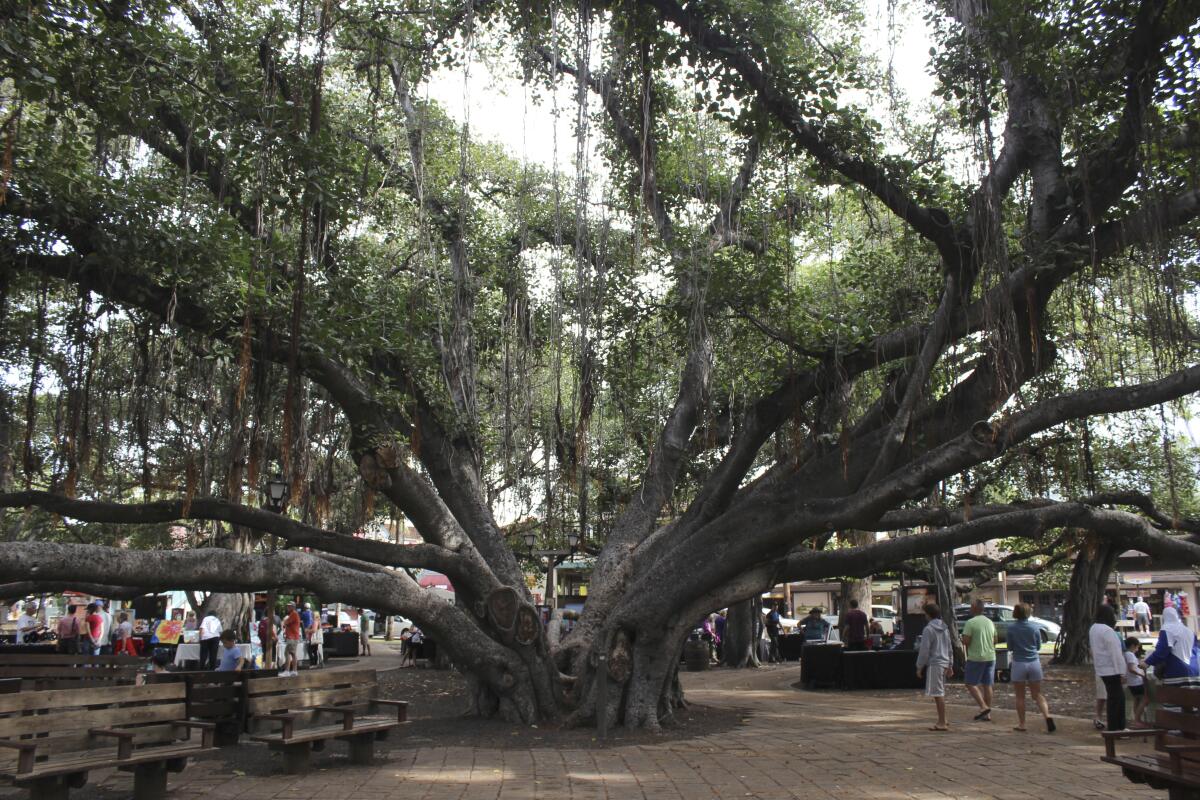
I was there with my family last week, an annual getaway that we have honed into regular stops in this picturesque place with its 150-year-old Banyan tree that covers an entire block, reportedly now charred and leafless, and a promenade with glorious views across the harbor.
Sushi, gelato, bikini shopping for teenagers — we had it down to an art.
Outside of the historic Baldwin House, we stopped to watch a family of wild chickens, which roam free just about everywhere on Maui, then lined up for a ferry ride to Lanai to visit the cat sanctuary on an island owned by a billionaire.
In between, my oldest bought a shot glass souvenir to add to a collection.
Pure tourists, like the thousands of folks around us, were hanging out in Lahaina on a break from the beach, fueling its economy and its image as a place for mai tais in oversized glasses.
But Lahaina is different from other vacation spots on Maui — such as Kapalua to the north or Wailea to the south — where the community was created for outsiders. There, you’ll find the Ritz-Carltons and Fairmonts, the 18-hole golf courses and gated second or third homes of the wealthy.
Residents of Lahaina, by contrast, “are a community that depends on each other,” Lindsey said. “They are almost like a whole big family.”
The downside of all that tourism is inflated prices, especially for real estate. Maui is considered Hawaii’s least-affordable county, with a median home price topping $1 million. It would require a $200,000 annual salary to buy the average single-family home, and then would require nearly 100% of annual average wages to pay for it.
In Lahaina, the median household income is about $80,000, but the median price for a home is more than $700,000, already unaffordable before this havoc.
A program in Maui that offers $30,000 in down payment assistance has had trouble finding takers because applicants simply don’t have enough financial stability to meet lending requirements, even with the help.
Renting is no better. Some affordable housing communities in Maui — of which there are not enough — have wait lists 12 years long. Fixing that backlog was a key topic in the last mayor’s race, but even with a new administration that has prioritized building, more units remain years away.
Wildfires on the Hawaiian island of Maui have killed at least 36 people, displaced thousands of residents and destroyed hundreds of structures, including homes, businesses and a school, prompting President Biden to declare a “major disaster.”
Lahaina was once the residence of King Kamehameha III, who conquered the chiefs of all the other islands to unify Hawaii. Later, Lahaina became the capital of that kingdom until 1845, when it was moved to Honolulu. Through various eras of the island’s history, it has been a center for whaling, for the shipping of sugarcane and pineapples and even for spiritual life, from the traditions of its Native people that honor ocean and land to the missionaries who brought the gods of the West.
“There is so much history that will be forever lost, a history that tethers all of us, young and old, not only to the ʻāina [respect for the land], but to ourselves and to each other,” Lindsey wrote in a statement on Wednesday.
Through all of that history, Lahaina has remained a town for locals, a place where people went to school, worked and lived in the modest single-story homes that seem both weathered and idyllic to this outsider.
There was a Catholic Church where the bell tolled regularly and where the doors were always wide open. A nearby house was selling a litter of golden retriever puppies while we were there. Down the street, workers on their lunch break ate Spam musubi.
I have covered my share of wildfires, and I can tell you what they will find when they do come back: Knee-deep ashes made from their possessions; car rims melted into puddles from the impossible heat; bits and pieces that somehow survived — a ring, a book, a singed photo.
And then the realization that they have lost not just everything they have, but everything they have known. They are alive, but without the life that only days ago seemed stable, if imperfect.
They have become climate migrants who will be forced to live elsewhere, maybe for weeks, likely for months or years if not forever. The family ethos that was the heart of Lahaina will be stretched and frayed as people focus on survival. Keeping that intact, the “most important thing,” as Lindsey describes it, will be even harder than rebuilding the physical structures.
She points out that the Native traditions and a love of the land hold people to this place more than most. She thinks people will stay in Maui, and in Lahaina. But she also saw Maui locals arriving at the airport in Oahu when she traveled there for a meeting Thursday.
“I was just so shocked,” she told me. “And then I thought, ‘Well, I can understand.’”
Because climate disasters don’t just dislocate people, they break apart communities and those ethereal ties that bind in ways that are not apparent until they are missing. There are no blueprints for rebuilding those.
This is what Mother Nature is screaming at us, as we try to ignore her. There are things we can never put back together once they are gone.
The town of Lahaina will be rebuilt as something new, probably led by the tourist economy. There will be gelato and mai tais.
The soul of Lahaina is a different matter. Now is a time of grief for so many lost loved ones, a time to offer help and respect.
Healing will come later. Many will stay and rebuild.
But what was no longer is, and the ties that bind climate change to personal chaos are growing with monstrous speed.
Watch L.A. Times Today at 7 p.m. on Spectrum News 1 on Channel 1 or live stream on the Spectrum News App. Palos Verdes Peninsula and Orange County viewers can watch on Cox Systems on channel 99.
More to Read
Sign up for Essential California
The most important California stories and recommendations in your inbox every morning.
You may occasionally receive promotional content from the Los Angeles Times.
